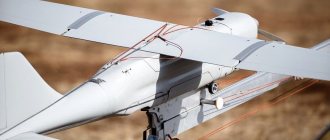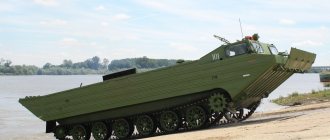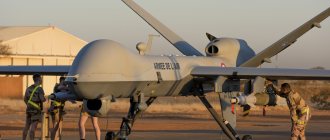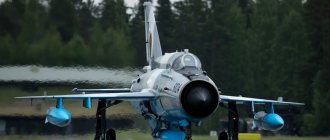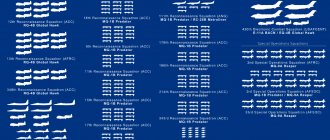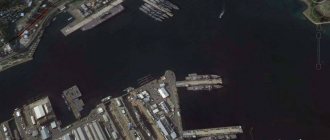RQ-4 Global Hawk is a US-made strategic reconnaissance UAV.
On February 28, 1998, he made his first flight from an air force base in California. In 2004, the first aircraft was transferred to the US Navy. In March 2006, he began performing combat missions.
For 30 hours, the device can patrol at an altitude of up to 18 thousand meters. Created by Teledyne Ryan Aeronautica, an American company (a subsidiary of Northrop Grumman).
The US Air Force in January 2012 decided to freeze the purchase of the RQ-4 Global Hawk in such a modification as Block 30. Previously accepted aircraft are planned to be transferred to reserve. The main reason is the expensive maintenance of the devices, which significantly exceeds the costs of using the Lockheed U-2.
Then, in 2013, the US Department of Defense decided to allocate $1.2 billion for the purchase of the 6 RQ-4 aircraft in the Block 40 modification from a military budget of $525 billion.
Design of the RQ-4 Global Hawk
Glider
The RQ-4 is made according to a normal aerodynamic design. The wing consists of a composite material, which is built on the basis of carbon fiber. The V-shaped tail consists of composite materials. The fuselage is a semi-monocoque and consists of aluminum alloys. The length is 13.3 m, the wingspan is 35 m, and the take-off weight is approximately 15 tons.
Specifications (RQ-4A)
General characteristics
- Crew:
0 - Load:
1636,6 - Longitude:
13,54 - Wingspan:
35,41 - Empty weight:
3851 - Curb weight:
10 387 - Engine plant:
.
Performance
- Maximum operating speed (V no):
800 km/h - Cruising speed (Vc):
650 km/
h - Radius of action :
24 985 - Combat range:
36 h. - Flight ceiling:
19 812
Equipment
The aircraft package consists of a ground and air segment, a maintenance segment and trained personnel. As for the air segment, it includes UAVs with various sensors, data transmission systems and avionics. The ground segment consists of maintenance and launch equipment, a ground control system with ground communication equipment. All ground mobility equipment is located on special trailers or in containers.
The RQ-4 Global Hawk is equipped with the HISAR integrated intelligence and surveillance system. This is a cheaper, simplified version of the ASARS-2, created by Hughes for the Lockheed U-2 reconnaissance aircraft. This complex is used on board the RC-7B UAV and is aimed at the international market. The complex also includes infrared and optical sensors, SAR/MTI radar. These subsystems can be used simultaneously, and their data is processed by one processor. They can be transmitted in real time to the ground via satellite or line-of-sight (50 Mbit/s).
The radar was developed by Raytheon (Hughes). It is able to operate without failure in any weather conditions. It allows you to obtain a radar image in normal operation with a resolution of 1 m. According to statistics, you can obtain an image from an area of 138 thousand square meters per day. m at a distance of 200 km. In point mode, surveying an area of 2x2 kilometers, per day you can get more than 1900 images with a resolution of 0.3 m Global Hawk. The SAR/MTI subsystem operates in the X-band and is capable of providing:
- detection and scanning of a moving target within 100 km;
- in detail mode, the resolution is 1.8 m on an area of 10 square meters. km;
- observation in combined mode with a resolution of 6 m over a strip with a length of 20 to 110 km and a width of 37 km.
The radar can detect ground moving objects and provide data transmission about them (speed and coordinates) in text messages.
The electro-optical camera is made by Hughes. With its help you can obtain high-quality images. The sensor is paired with a telephoto lens that has a telephoto lens with a distance of 1750 mm. There are 2 operating modes: scanning a 10 km strip, imaging an area of 2x2 km.
The image from the OE/IR sensors and radar is processed on board the UAV and transmitted in the form of separate frames to the ground station. In turn, the ground station consists of image frames and prepares them for later use.
A corrected inertial system is used for navigation. Global Hawk is used for autonomous flight and transmission of intelligence data via satellite channels to a ground station (VHF and Ku bands). If the aircraft is to be used in line of sight, it is possible to transmit data directly to a suitable ground station.
RQ-4 Global Hawk video
The ground segment, consisting of maintenance equipment, launch equipment and a ground control system, is also produced by Raytheon. MCEs are designed for setting tasks, monitoring and control, transmission and image processing. The LRE is used to launch the RQ-4 Global Hawk as well as search. It includes LRE equipment for calculating GPS system corrections, which allows determining the exact position of the UAV during landing and takeoff. The rest of the time, the main navigation aid is the inertial system. During missions, the LRE and MCE may be located in different locations (usually the MCE is located at the command location). These systems are located in fortified shelters and have external antennas for satellite and direct communications.
Army and weapons
The RQ-4 Global Hawk unmanned aerial vehicle (called Tier II+ during its creation), developed by Northrop Grumman (formerly Ryan Aeronautical), is actively used by the US Air Force and Navy in reconnaissance operations.
The RQ-4 Global Hawk's role is similar to that of the Lockheed U-2 spy plane in 1950. It is an extremely useful reconnaissance and surveillance tool. To accomplish its mission, the RQ-4 is equipped with a synthetic aperture radar that penetrates clouds and sandstorms, and an electro-optical/infrared (EO/IR) imaging system that is capable of recording over 100,000 km of ground per day over a 200 km area. When the spot mode is turned on, shooting is done frame by frame, and over 1900 images of 2 x 2 km areas with a resolution of 1 m can be obtained per day.
The range of tasks assigned to the Global Hawk includes reconnaissance to provide troops with information in peacetime and war. According to the Air Force, the use of the device improves the targeting accuracy of precision weapons and also improves the protection of troops on the front line.
The cost of one machine is about $35 million (including development, the cost reaches $123.2 million). Development
The first 7 vehicles were created as part of the Advanced Technology Demonstration (ACTD) program, funded by DARPA, and were intended to evaluate the capabilities of performing special missions. The global situation ensured high demand for this UAV, and the first prototypes were immediately sent to Afghanistan.
Production of the RQ-4 Global Hawk got off to a rather unusual start, as one-off units were produced in parallel with ongoing development. Nine Block 10 UAVs (sometimes called the RQ-4A model) were produced, two of which were immediately purchased by the United States Navy. Three devices were sent to Iraq. The last Block 10 UAVs were received on June 26, 2006.
To improve the characteristics of the device, its body was modified, the nose and wings were extended. The new model, called the RQ-4B Block 20, could carry 1,360 kg in its internal compartments. The Block 20 prototype, the 17th produced by Global Hawk, was demonstrated on August 25, 2006. On March 1, 2007, the aircraft made its maiden flight from Plant 42 Air Force Base in Palmdale, California to Edwards Air Force Base. Development of the Block 20 UAV continued in 2008. The following modifications of the device - Block 30 and 40, developed in 2008-2010, have dimensions similar to Block 20.
Cost overrun
Cost overruns during the creation of Global Hawk brought the program to the brink of closure. The overexpenditure for one sample in mid-2006 amounted to 25% of the estimated cost, which was unreasonable. However, in June 2006, the Global Hawk program was restructured. Due to production and development backlogs, the Air Force's final operational assessment report was delayed from August 2005 to November 2007. The report was released in March and planned for production of 54 aircraft by 2015. The plan also included the sale of the Global Hawk to five countries, including the United States and Germany.
US Navy version
The United States Navy acquired two examples of Block 10, designated N-1 (BuNo 166509) and N-2 (BuNo 166510), to evaluate its utility in maritime patrol. Initially, they were tested for several months at Edwards Air Force Base, and later, on March 28, 2006, they were relocated to the US Naval Air Station at Patuxent River (NAS Patuxent River) to participate in the Global Hawk Maritime Demonstration program GHMD. The VX-20 squadron was equipped with GHMD systems.
The GHMD devices first flew in July 2006 in the coastal zone of the world's oceans (Rim of the Pacific). Although RIMPAC testing took place near Hawaii, the vehicle took off from Edwards Air Force Base, which required a 4,000 km flight to the operating area. There were 4 flights that included 24 hours of continuous maritime surveillance coordinated by the USS Abraham Lincoln and USS Bonhomme Richard. The test program consisted of maintaining maritime situational awareness, tracking and terrain scanning.
The image from the Global Hawk was transmitted to Patuxent River Air Force Base, which was processed before being sent to ships in Hawaii, so the test was characterized by the global scale of the air operation.
Northrop Grumman submitted the RQ-4B model to the Broad Area Maritime Surveillance competition, which was expected to result in a contract. On April 22, 2008, the RQ-4N model won and, due to the proposed price, a contract worth $1.16 billion was awarded to the US Navy. In September 2010, the RQ-4N was officially redesignated MQ-4C.
Design
The RQ-4 UAV is equipped with an Allison Rolls-Royce AE3007H turbofan engine with a power of 3200 kgf/31.4 kN and can carry 900 kg of payload. The fuselage is made of aluminum, semi-monocoque construction, while the wings and tail are made of lightweight, high-strength composite materials.
Global Hawk is the first UAV approved for flight in civil space by the US Federal Aviation Administration. This is definitely an achievement and could serve as a basis for the introduction of unmanned passenger airliners.
Comparison of the PQ-4A and PQ4B airframe.
Integrated Systems
The Global Hawk's systems include aircraft systems—sensors, avionics, and communications; ground part - launch and maintenance elements, control elements with ground communication equipment; service staff; elements of personnel training.
The integrated sensor suite is provided by Raytheon and includes synthetic aperture radar (SAR), electro-optical (EO) and infrared (IR) sensors. Both EO and IR sensors can function in conjunction with SAR. The SAR has a ground target motion detection mode that reports the speed and positions of targets. SAR and EO/IR images are processed on board the device and transmitted as separate frames to the task controls. The control unit can combine frames into a single image before sending them later. Navigation is inertial navigation via Global Positioning Satellite System. The Global Hawk UAV can operate autonomously or “tethered” via a satellite communications system (Ku- and UHF-band). When the drone operates in line of sight, data is transmitted via direct communication.
The Global Hawk ground segment includes the mission control unit and launch and maintenance elements manufactured by Raytheon. The job control unit is used to plan, control, process and transmit images. The launch and maintenance system provides precise differential global positioning system correction for precise takeoff and landing, while the flight uses GPS with an inertial navigation system. Due to the separation of the elements of the ground station, each part of it can be located in a different part of the world. The job control unit is often located together with the main control point. Both elements are placed in a military container along with an internal antenna for direct communication and satellite communication equipment. Global Hawk and its EO/IR sensor unit.
Sensor kit
Clickable image
Global Hawk carries the Hughes Integrated Surveillance and Reconnaissance System (HISAR). HISAR is a cheap analogue of the ASARS-2 kit, which Hughes developed for the Lockheed U-2. HISAR is also included in the ARL-M airborne electronic reconnaissance system, based on the RC-7B reconnaissance aircraft that are sold on the international arms market. HISAR combines SAR and motion indicator, as well as an EO and IR imaging unit. All three sensors are controlled by a single processor. Digital data from the sensors, either through direct communication or via satellite, is transmitted to the ground station at a speed of 50 Mbit/sec in real time.
The SAR/Target Motion Indicator system operates in the X-band and provides several operating modes: 1. Zone Motion Indicator mode can detect target movement within a 100 km radius. 2. Combined strip mode SAR/target motion indicator provides a resolution of 6 m in a 37 km band in the range of 20-110 km. 3. SAR point mode provides a resolution of 1.8 m per 10 km2, as well as marine surveillance functions.
The visible and IR photodetectors are part of a single articulating mechanism, and use a common telephoto lens with a focal length of 1750 mm. The kit can be additionally equipped with an electronic reconnaissance kit. To enhance surveillance capabilities, the Global Haw is equipped with Raytheon's AN/ALR-89 self-protection suite, which includes the AN/AVR-3 laser warning system, AN/APR-49 radiation warning receiver and jamming system. In addition, the drone uses an ALE-50 trailed decoy against enemy air defense.
In July 2006, Edwards AFB began testing an upgraded version of the Global Hawk Block 30 at the new Benefield Anechoic Facility (an antenna range designed to test avionics that require large chambers with radar-absorbing coating). This model had an extremely sensitive SIGINT processor known as the Advanced Signals Intelligence Payload.
In September 2006, testing was conducted with a dedicated radar, the Multi-Platform Radar Technology Insertion Program (MP-RTIP), aboard Scaled Composites' Proteus aircraft. Once approved, the system was installed on one Global Hawk. The Air Force has previously considered multiple MP-RTIP options (known as area surveillance sensors or WAS sensors) for the E-10 MC2A indoor testbed and Joint STARS aircraft. In August 2010, Northrop Grumman introduced a new version, Block 40, which entered production. It has new capabilities, including MP-RTIP radar, surveillance priority over reconnaissance. Block 40 also has a modified chassis.
US Air Force
History The Global Hawk completed test flights while stationed at the 452nd Test Squadron, Edwards AFB.
The current unit is part of the 9th Reconnaissance Wing, 12th Reconnaissance Squadron at Biel Air Base. Prototypes of the Global Hawk ATCD were used in Afghanistan and Iraq. Since April 2010, they have been flying along the Northern Route, from Beale Air Force Base over Canada to Northeast Asia and back, significantly reducing approach times and patrol times. While the vehicle's intelligence-gathering capabilities are commendable, the program has already lost three prototypes and more than a quarter of all Global Hawk drones in the wars. According to the Australian press, the crashes were caused by "technical problems or poor operation." The failure rate per 1 hour of flight is 100 times higher than that of F-16 fighters in the same war. The manufacturer noted that it is unfair to compare problems between the final model and the prototypes. Three Global Hawk UAVs were lost as a result of accidents
Records
On March 21, 2001, aircraft number 982003, the third ACTD prototype, set an official flight endurance record, departing Edwards for 30 hours, 24 minutes, and 1 second. The drone made a flight of 19,928 meters, which was later beaten by NASA's Helios prototype.
On April 24, 2001, a Global Hawk UAV flew without refueling from Edwards AFB to Edinburgh Air Force Base, Australia, becoming the first unmanned aircraft to fly across the world's oceans. The flight covered 13,219.86 meters and took 22 hours. On February 11, 2010, Global Hawks reached 30,000 combat hours.
NASA
In December 2007, two drones were transferred to the United States Air Force's Drayden Science Center, Edwards AFB. Based on the requirements for high-altitude, long-duration flights to study the Earth, testing of the Global Hawk began. The 1st, 6th and 7th vehicles, built under the program to demonstrate advanced technologies that were no longer needed by the military, entered NASA service. Northrop Grumman, as a NASA partner, helped test new technologies on the drone, which opened up new markets for it, including civilian applications.
According to an article in Scientific American (March 2010, pp. 25-27), the National Aeronautics and Space Administration was testing a UAV in October 2009, while the Global Hawk began being used in science operations in March 2010. Initially, the UAV was used to measurements of the ozone layer and the transport of pollution across the world's oceans. The authors of the article believe that the drones could have been used for Antarctic exploration when they were based and operating in Chile. In August and September 2010, one of the two devices participated in NASA's Genesis and Rapid Intensification Program. As a high-altitude, long-endurance UAV, the Global Hawk was ideal for monitoring the Atlantic basin for hurricanes. It was equipped with weather sensors, including a Ku-band radar, a lightning display sensor and cameras from which a parachute radiosonde (Dropsonde) is ejected.
NATO
NATO expects to receive 8 Global Hawk UAVs with MP-RTIP radars by 2012. A total of $1 billion will be spent on the project, although the contract with Northrop Grumman has not yet been concluded.
Luftwaffe
The German Air Force installed European sensors on the RQ-4B, dubbing it the EuroHawk. The vehicle retained the original airframe, but received reconnaissance equipment from EADS. Germany has decided to finally replace the outdated Breguet Atlantic reconnaissance aircraft, which has been decommissioned since July 2010. The UAV is based on the Blok 20/30/40 RQ-4B models, but is equipped with the EADS SIGINT suite. The sensor set includes 6 wing hangers, of which one is inherited from the Global Hawk. The EuroHawk officially entered service on October 8, 2009, and made its first flight on June 29, 2010. It underwent several months of flight testing at Edwards AFB before beginning to fly in Germany in May 2011. It was initially assigned to WTD61, Ingolstadt Airport. Manching. The cost of the first 5 vehicles was 430 million € for development and the same amount for purchase.
Potential operators
Australia was considering the possibility of purchasing several devices for maritime and land surveillance. During testing in 2007, the Global Hawk and RQ-1 Mariner were compared. If the former had been chosen, then the Global Hawk would have operated alongside manned P-8A Poseidon aircraft as part of Nos 10 and 11 Squadrons. This or a second (together with the RQ-1 Mariner) combination should replace the existing AP-3C Orion aircraft by 2022. Given the current economic situation, the Australian government has decided to refuse.
Canada is also a potential buyer. They want to replace the CP-140 Aurora patrol aircraft designed for maritime and land surveillance. The new drones will also help remove ground border guards from the Arctic. Similar reasons prompted Spain to enter into a contract with Northrop Grumman.
Japan would also like to buy a UAV, but they cannot find the funds.
North Korea's defense acquisition agency is extremely interested in purchasing four RQ-4Bs by 2012. They are needed to enhance surveillance capabilities and regain operational control over the United States and South Korea. The contract is valued at $19 million. The proposal has sparked heated debate within the US administration, which is concerned about whether the buyer will use the new vehicles for its own UAV development program.
New Zealand had also previously expressed interest in Global Hawk, which was intended to monitor the Atlantic Ocean around Antarctica and the Mariana Islands. Later, the buyer turned his attention to the IAI Heron UAV and the Kahu, a hand-launched vehicle under development. India is also a potential buyer.
RQ-4A
models were the Air Force's initial design, with 16 built.
RQ-4B
– improved version with increased payload, wingspan increased to 39.8 meters, length up to 14.5 meters.
The flight range was reduced to 8,700 km. RQ-4E
– German Euro Hawk.
Model RQ-4B, equipped by EADS with electronic reconnaissance equipment. MQ-4C
– originally called RQ-4N.
The device is designed for zonal maritime surveillance. KQ-4
– currently under development.
Presumably, it will be a completely autonomous device. Miniature Variants
As part of the Hunter-Killer program, Scaled Composites and Northrop Grumman also introduced a 50% scale replica of the RQ-4A, called the Model 396.
US Operators US Air Force Air Combat Command
9th Reconnaissance Wing - Beale AFB, California
1st Reconnaissance Squadron
12th Reconnaissance Squadron
53rd Airlift Wing
31st Test Squadron - Edwards AFB, California Air Force Reserve Command
940th Airlift Wing - Beale AFB, California
13th Reconnaissance Squadron - Beale AFB, California US Navy
NASA
Drayden Science Center
Characteristics
Crew: 0
Length: 13.54 m
Wingspan: 35.41 m
Height: 4.62 m
Empty weight: 3.851 kg
Maximum take-off weight: 10.387 kg
Powerplant: 1 × Allison Rolls-Royce AE3007H turboprop engine, power 3200 kgf / 31.4 kN
Maximum speed: 800 km/h;
Cruising speed: 650 km/h
Flight range: 24.985 km
Endurance: 36 hours
Working ceiling: 19.812 m —— en.wikipedia.org/wiki/Northrop_Grumman_RQ-4_Global_Hawk commons.wikimedia.org/wiki/File:RQ-4_Global_Hawk.jpg sobchak.files.wordpress.com/2009/08/globalhawkcutaway.jpg 1. bp.blogspot.com/_SuL-22JZ-eU/S80D6HHJt8I/AAAAAAAAITk/J_ywQFBcwKw/s1600/Global+Hawk+(GloPac)4.jpg
RQ-4 Global Hawk modifications
- AV – NASA acquired two GloPac atmospheric research UAVs in 2007. In 2009, the refurbishment was completed. The modified aircraft could rise to a height of 20 km with heavy scientific equipment on board (907 kg).
- The RQ-4A Global Hawk is a basic modification.
− Block 10 : a total of seven UAVs were built, which were decommissioned in 2011.
- RQ-4B Global Hawk . This includes three modifications:
− Block 20,
− Block 30,
− Block 40.
- The RQ-4E Euro Hawk is a German modification of the RQ-4, developed by the aerospace concern EADS and Northrop Grumman Corporation. In October 2009 it was introduced to the market.
- The MQ-4C Triton is a maritime patrol aircraft based on the RQ-4 Global Hawk. It has an X-band radar designed to detect various surface ships and is part of the US Navy's advanced maritime surveillance capability.
- Polar Hawk is a modification that will be used by Canadian forces. It is based on Block 30. The aircraft is adapted to operate even in very cold conditions. It can rise to a height of up to 18.3 thousand meters and conduct continuous surveillance for 33 hours.
Operating history
Flight testing for the United States Air Force was conducted by the 452nd Flight Test Squadron at Edwards Air Force Base. The aircraft was used by the 9th Reconnaissance Wing and the 12th Reconnaissance Squadron from Beale Air Force Base.
Prototypes of the Global Hawk ATCD were used in the Afghanistan War and the Iraq War. Since April 2010, they have also flown the "Northern Route" from Beale Air Force Base to Canada and Southeast Asia, demonstrating cost and flight time reductions in surveillance missions. [ 6 ]Operators using it are looking for an aircraft that is ready for any mission. Its data collection capabilities are praised, but the aircraft still suffers from a high rate of accidents, with 2 aircraft lost in testing and more than a quarter of those used in combat missing in action. According to Australian press reports, the accidents, which were due to "technical failures or poor maintenance", resulted in a failure rate per combat hour that was 100 times that of the F-16. The manufacturer argued that it was unfair to compare a complete aircraft such as the F-16 to a prototype and that the maintenance carried out on the aircraft was not the same as that of a conventional fighter. As of November 2010, three Global Hawks have been lost in accidents. [ 7 ] [ ] [ ]
records
On March 21, 2001, aircraft #982003, the third ACTD produced, set a UAV flight endurance record of 30 hours, 24 minutes, and 1 second when it departed Edwards. [10] During the same flight, he broke the absolute altitude record of 19,928 meters, which was later surpassed by NASA, with the Helios prototype.
On April 24, 2001, Global Hawk flew non-stop between Edwards AFB in the United States and Edinburgh AFB in Australia, making history as it would be the first unmanned flight over the Pacific Ocean. The flight lasted 22 hours, breaking the record for absolute distance traveled by a UAV - 13,219.86 km (average speed: 600.90 km/h).
As of 11 February 2010, Global Hawks had logged 30,000 combat hours and flown more than 1,500 sorties. [ eleven ]
Shot down by Iran
On June 19, 2022, a US Navy RQ-4A BAMS-D flying over Iranian airspace in the Persian Gulf near the Strait of Hormuz was shot down by a Khordad surface-to-air missile fired from the Gharuk area, Iran, in the context of the crisis in the Persian Gulf 2019-2020.
Global Hawk cost and potential operators
The price of the aircraft is estimated at up to $140 million (this does not include R&D costs). An hour of flight costs $31 thousand.
Canada is a potential buyer who wants to use the aircraft to monitor remote areas of the Arctic. Moreover, the Global Hawk will complement or replace the patrol CP-140 Aurora.
Japan was interested in three Global Hawks.
Spain has plans to purchase aircraft and has already signed contracts with Northrop Grumman.
New Zealand is also making plans for the RQ-4 Global Hawk, eyeing it for potential surveillance of the Pacific Islands and Southern Ocean. The modern Kahu drone and IAI Heron can also be used for these purposes.
options
RK-4A RK-4B RK-4N performs maritime surveillance duties in the United States Navy. RQ-4 Triton US Navy version [12]
Miniature version
Scaled Composites and Northrop Grumman also offer the original 50% scale RQ-4A aircraft, currently known as the Model 396, which participates in the USAF Hunter-Killer program.
EuroHawk
The German government, together with the European Union, manufactured five aircraft under license from Northrop Grumman, but in 2013 the German aviation authority refused to certify the Eurohawk to operate in German civil airspace as it did not have ACAS (collision avoidance system) and was already being upgraded to comply with regulations could lead to a significant increase in costs and does not guarantee certification, the German Ministry of Defense decided not to purchase five aircraft and cancel the program with the first prototype already completed and the second device closed. be delivered. [ 13 ] [ ] [ ][ 16 ]
In 2013, the Polish government ordered five aircraft for its air force. [ 17 ]
see also
- Unmanned aerial vehicle
- Result-X
- UAV
- UAV
Related developments
- Scaled Composites Model 396
- Northrop Grumman MQ-4C Triton
Similar aircraft
- RQ-3 Darkstar
- General Atomics MQ-9 Reaper
- Guizhou Soaring Eagle
- Soaring Dragon Guizhou
- EADS Thalarion
- IAI Eitan
Notation sequences
- _Q-_
Sequence (US Unmanned Aerial Vehicles, 1962-present): Q-1 / - Q-2 - Q-3 -
Q-4
/ - Q-5 - Q-6 - Q-7 →
related lists
- Application: Unmanned Aerial Vehicles
- Appendix: US Air Force Aircraft (Historic and Modern)
References
- ↑ a b
https://costofwar.com/en/publications/2011/analysis-fiscal-year-2012-pentagon-spending-request/ - https://www.deagel.com/AEWandC-ISR-and-EW-Aircraft/Euro-Hawk_a000556003.aspx
- https://web.archive.org/web/20110717062730/https://ellinceanalista.wordpress.com/category/aviacion-militar/
- "$143 million in Global Hawk cost overruns", Defense Industry Daily, April 25, 2005.
- "Expensive Drone Poised to Replace U-2 Spy Plane" New York Times, August 2, 2011.
- https://theasiandefence.blogspot.com/2010/06/global-hawk-to-take-on-northern-route.html
- "Archival copy". Archived from the original on August 28, 2009. Retrieved August 12, 2009
- Global Hawk crash unlikely to harm the program
- A high-altitude American spy plane crashed in Pakistan; Engine failure mentioned
- FAI World Records Database.
- [1]
- https://defensetech.org/2013/04/11/navy-delays-triton-uas-development/
- https://www.faz.net/aktuell/politik/eine-milliarde-euro-senkt-euro-hawk-wird-nicht-zuallowed-12181768.html
- https://www.meneame.net/
- https://web.archive.org/web/20130607183512/https://www.tagesschau.de/inland/eurohawk102.html
- https://www.defenseindustrydaily.com/euro-hawk-program-cleared-for-takeoff-03051/
- https://www.infodefensa.com/?noticia=polonia-joins-the-programme-for-the-purchase-of-five-drones-global-hawk-of-the-nato
operators
Maintenance personnel prepare a Global Hawk for testing at Beale Air Force Base. US
- USAF Air Combat Command 9th Reconnaissance Wing - Beale AFB, California 12th Reconnaissance Squadron
- 53.ª Ala [[31. eɽ Test and Evaluation Squadron]] - Edwards AFB, California
- 610th Regional Group [[13. eɽ Reconnaissance Squadron]] - Beale Air Force Base, California

